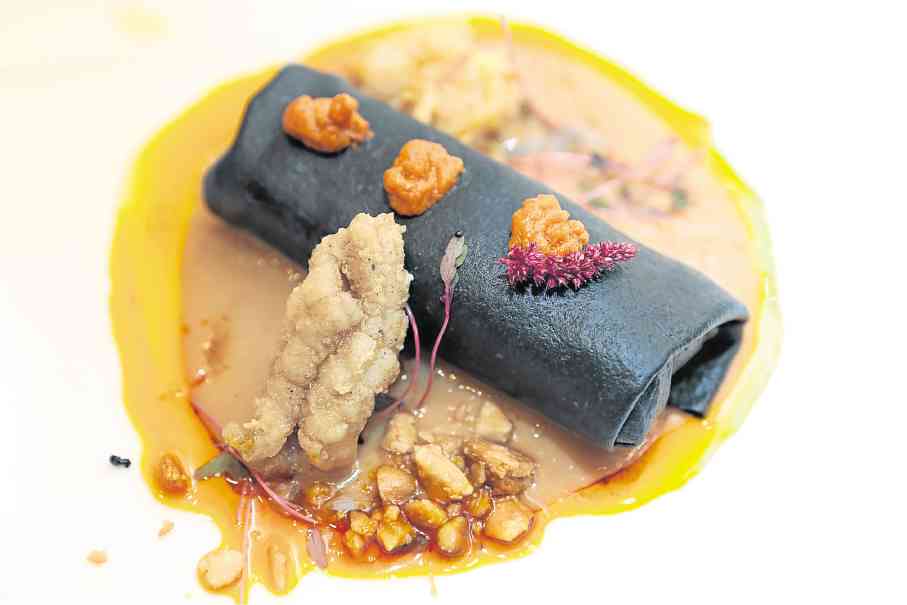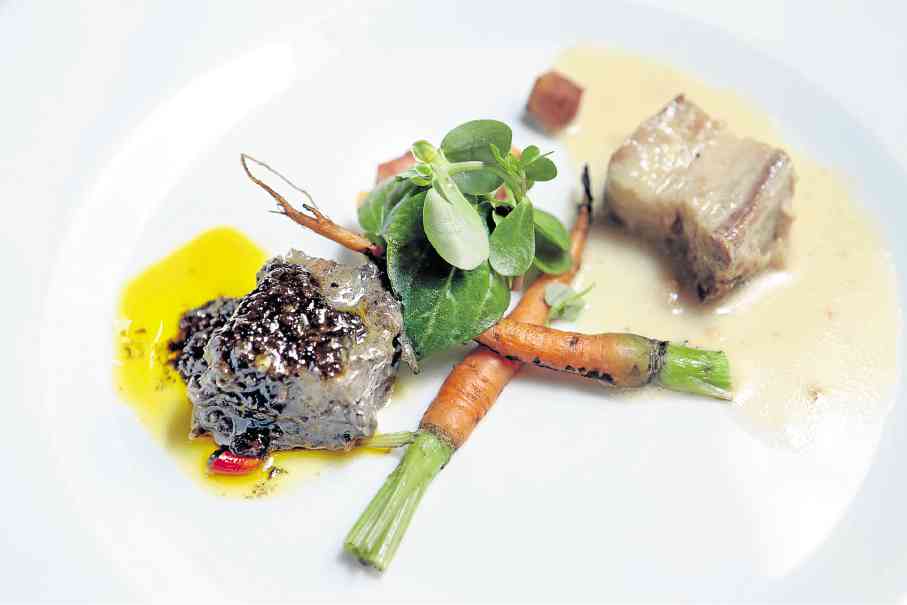Mindanaoan cuisine, anyone?
Mission: Manila
Last Tuesday, at the Mission: Manila dinner featuring chef Myke Tatung Sarthou, we got to try the flavors of Mindanao. (Mission: Manila is a passion project of mine to promote Filipino chefs and Philippine cuisine.)
Guests were served kuning, a Maranao rice dish mixed with turmeric. It reminded me of Pampanga’s bringhe, while my VIP seatmate Mielle Esteban of Arum Estrategies de Internacionalización (the company that brought Madrid Fusion to Manila) thought of paella.
We also got a taste of palapa, a quintessential Maranaoan condiment of chili and native scallions called sakurab. We also learned that they call their local sea urchin, tihi-tihi, and their local oysters, sisi.
For the entree using Kitayama Wagyu, Tatung made us compare the Tausug’s pyanggang using burnt coconut with the Tagalog adobo sa gata. And what we thought would be a simple ensalada turned out to be a showcase of Mindanaoan fruits, with some guests appreciating for the first time Pajo mango from Davao alongside Mindanao pomelo and dragon fruit.
Flavors of the Philippines
The Mission: Manila dinner, a collaboration with Raffles Makati, was a resounding success, with each dish enlightening guests—as the dinner theme promised—on the Flavors from Across the Archipelago.
The 8-course dinner started with a kinilaw inspired by the Butuanon people, the people of the sea from Agusan del Norte. This was followed by lumpia inspired by the decadent Negrenses; then dinakdakan by the Ilokanos; sinigang by the Pampangenos; pyanggang of the Tausugs; and kuning of the Maranaos.
Aside from the regional inspirations, what piqued guests’ curiosities was how Tatung gave each dish a twist. For one, the tuna for the kinilaw wasn’t soaked in vinegar. It was smoked. What was soaked in vinegar was what it was perched on: Pickled watermelon rind.
Another avante garde interpretation was the sinigang that was not a soup. It was a little bite of lechon with a tamarind and guava puree on the side, with liver pate daintily atop a slither of eggplant.
Guests were delighted. Esteban described Tatung’s work as “exquisite” while food writer CJ Juntereal observed that Tatung had really grown more sophisticated as a chef.
And she’s right. Most impressive was the chef’s take on lumpia. Tatung created a squid-ink wrapper so it was black, and on top were bright orange dots of aligue. Underneath was a bed of peanut sauce. And inside, succulent aswang lobsters from Lobster House Manila. So on a beautiful, artful plate alive with color, he had umami from the lobsters, sweetness from the peanut sauce and saltiness from the aligue.
It all came together cohesively. Impressive.
Rising star
I first tasted the food of Tatung almost 10 years ago when he just arrived on the scene and I was a random walk-in at Chef Tatung’s in Quezon City. I still remember that day. I was with The Good Doctor, who discovered the place and tipped me about it, patiently giving me directions when I got lost on the way.
When I arrived, the restaurant was empty and I think Tatung had just woken up (he lived in the same house). Then he started cooking for us, the only guests at the restaurant on a weekday at noon. He served a simple Thai-inspired fish and he was selling himself as an Asian chef, not just Filipino.
Back then, he already had the promise of a chef with a fervor for flavors. I even raved about the discovery in the Sunday Inquirer Magazine.
I am so happy that instead of focusing on recipes from other Southeast Asian countries, he has gone back to his Filipino roots, realizing that there are so many flavor profiles in our country alone and redesigning the dishes for the modern kitchen without sacrificing the essence of the heritage dishes.
He has also shown an impressive ability to transform traditional Filipino dishes into fine dining recipes that can be appreciated with wine. At the Mission: Manila dinner, each dish was expertly paired with wine.
The lumpia was paired by Wine Depot’s Brett Tolhurst with Banfi Le Rime Pinot Grigio while the sinigang was paired by Artisan Cellar Door’s Rey Co with Selbach Oster Riesling.
It’s no wonder that no less than Lourdes Plana, founding partner of Madrid Fusion, picked up on Tatung’s talent, inviting the chef to speak at Madrid Fusion in Spain. He did last January, becoming the first Filipino to speak at the Madrid Fusion auditorium.
On top of that, Tatung was also invited to do two dinners for the Madrid Fusion side event “Dinner with the Stars”: one for the noble Rothschilds and another partnering with Spain’s own chef Mario Sandoval (hot, handsome young chef of Restaurante Coque in Madrid) at Hotel Orfila.
Esteban, who attended the Rothschilds dinner, recalled that Tatung’s work was lauded as “exquisite.” It was the menu for the “Dinner with the Stars” that Tatung recreated for guests of Mission: Manila.
Continue watching this guy. His star is going to continue to shine and he may just conquer the world one Filipino regional dish at a time. Madrid Fusion was just the beginning.
Madrid Fusion Manila is happening April 6 to 8 at SMX Convention Center. Sign up and register at madridfusionmanila.com. For a schedule of Flavors of the Philippines dinners in support of Madrid Fusion, visit madridfusionmanila.com/flavors-of-the-philippines.
Tatung is the chef-owner of Agos on the ground floor of the North Wing of SM Mall of Asia. Find the ingredients from Tatung’s Flavors from Across the Archipelago through Instagram: @kitayamameatshop, @lobsterhousemanila, @downtoearthph, @myhomegrownorganic.
Raffles Makati, co-host of the Mission: Manila dinner, is located at 1 Raffles Drive, Makati Avenue, Makati. For event bookings, call +63 2 555 9777. Visit raffles.com.
To learn about how to pair Philippine cuisine with wine, look for Jaydon Hill, sommelier of Wine Depot, at 8901041 or visit Facebook @WineDepotPH.
For wine events, inquire at Artisan Cellar Door, Narita Building, 2276 Don Chino Roces Ext, Makati. Call 8800619 or follow @artisancellardoor.



